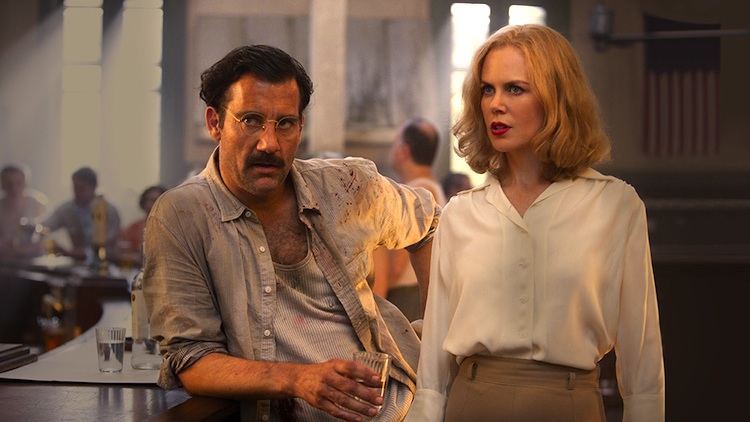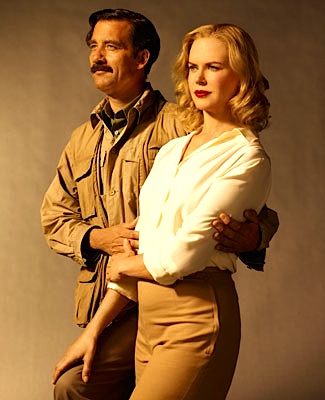By Joe Bendel. Ernest Hemingway deliberately cultivated his notoriously macho image – yet he somehow found four women willing to marry him at various points of his life. That was a lot of optimism, on everyone’s part. Though she had the shortest tenure as a “Mrs. Hemingway,” war correspondent Martha Gellhorn was the most notable. Matching and at times surpassing his feats of war zone journalistic daring, Gellhorn fired his passion and inspired his professional respect and jealousy. Their tempestuous relationship is dramatized in Philip Kaufman’s HBO Film Hemingway & Gellhorn now currently airing on the network.
When ambitious young magazine writer Martha Gellhorn first meets the funky, grungy Hemingway in a Key West bar, they can barely resist tearing the clothes off each other. The fact that he is married hardly matters to either of them. However, their animal attraction will have to briefly wait until they reunite covering the Spanish Civil War, at the behest of ardent Spanish Republican supporter John Dos Passos.
Working with Dutch Communist documentarian-propagandist Joris Ivens, Hemingway and Dos Passos film The Spanish Earth (with Gellhorn tagging along), for the purpose of rallying American audiences to the Republican cause. Frankly, it is considerable more compelling to watch their run-and-gun shooting process in H&G than the historical documentary itself. That adrenaline also fuels the war reporters’ torrid affair.
Just like Hemingway and Gellhorn’s relationship, the film really clicks during their time together in Spain. Viewers are served a liberal helping of Nationalist atrocities, but the portrayal of the Soviet forces is also refreshingly unvarnished, particularly with respects to the fatal purging of heroic Loyalist soldier Paco Zarra, a stand-in for Dos Passos’ doomed friend José Robles. While the literary power couple is shown fawning over Chou En-lai and sneering at the gauche Chiangs in China, Gellhorn also reports from Finland, unequivocally siding with the Finns against the Soviet invaders.

Unfortunately, the film loses vitality with the aging Hemingway, sliding into the long denouement of his dubious u-boat chasing Cuban years and sad final days in Idaho. By the time America enters WWII, screenwriters Jerry Stahl and Barbara Turner clearly suggest Gellhorn was more of a man than Hemingway. Of course, this is a common problem with bio-pics. To be accurate, they can almost never end with the good stuff.
Regardless of his character arc, Clive Owen totally goes for broke as Hemingway. One of the few actors working today who can come across as both manly and literate, he bellows and carouses with relish. It is a larger than life performance, bordering on camp, yet he is still able to convey Hemingway’s inner demons and nagging self-doubts. He also manages to dial it down periodically for some saucy Tracy-and-Hepburn bantering with Nicole Kidman’s Gellhorn. Likewise, Kidman is on a very short list of actresses who can play smart, sophisticated, and alluring, simultaneously. In fact, she could be channeling Hepburn and the Rosalind Russell of His Girl Friday as the fast-talking, khaki-wearing journalist crusading against injustice, which is frankly pretty cool.

In addition to the strong chemistry between the leads, H&G boasts a strong supporting ensemble. David Strathairn is particularly engaging as the disillusioned idealist, Dos Passos, serving as a subtle corrective to Hemingway’s ethical malleability. Metallica’s Lars Ulrich adds notable color as Ivens, while Tony Shaloub conveys a sense of both the menace and tragedy of the Stalinist true believer Mikhal Koltsov, who is considered to be the source for the Karkov character in For Whom the Bell Tolls. Again, the most inspired work comes during or prior to the Spanish Civil War sequences.
Frequently approximating the look of black-and-white news reels and Ivens’ documentary footage, H&G is highly cinematic (getting a vital assist from cinematographer Rogier Stoffers). Kaufman is a big canvas filmmaker, with sufficient artistic stature to merit a recent MoMA film retrospective—a high honor indeed. While steamier and gossipier than The Right Stuff, it is downright staid compared to his Henry & June and The Unbearable Lightness of Being.
An appropriately messy film sprawling all over the place, H&G is rowdily entertaining, capturing a good deal more historical insight than one would expect. Definitely recommended for those who appreciate the Hemingway oeuvre and persona (as well admirers of Gellhorn or Dos Passos), Hemingway & Gellhorn airs again on HBO June 2nd, 7th, 10th, 11th, 15th, and 19th and on HBO2 on June 4th, 6th, 12th, 17th, 21st, 25th, and 30th.
LFM GRADE: B
Posted on May 31st, 2012 at 9:21am.